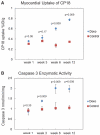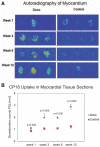Noninvasive molecular imaging of apoptosis in a mouse model of anthracycline-induced cardiotoxicity
- PMID: 25657296
- PMCID: PMC4384653
- DOI: 10.1161/CIRCIMAGING.114.001952
Noninvasive molecular imaging of apoptosis in a mouse model of anthracycline-induced cardiotoxicity
Abstract
Background: Anthracycline-induced cardiotoxicity and myocardial dysfunction may be associated with apoptosis. Caspase 3 catalyzes a terminal step in apoptosis, and its expression may serve as a marker of cardiomyocyte apoptosis. We synthesized 18F-CP18, a caspase-3 substrate and evaluated cardiac 18F-CP18 uptake in a mouse model of anthracycline cardiotoxicity.
Methods and results: For 12 weeks, mice were injected with doxorubicin, 3 mg/kg/week, or vehicle (control). Left ventricular fractional shortening was quantified by echocardiography. CP18 uptake after intravenous injection of 250 μCi of 18F-CP18, 24 hours post-doxorubicin treatment was quantified by microPET, autoradiography, and gamma counting. Apoptosis was assessed by enzymatic assay of myocardial caspase 3 and TUNEL staining of tissue sections. Compared with controls, at 6 and 12 weeks of doxorubicin treatment, fractional shortening was reduced (20.7%±2.5% versus 31%±3.5%, P=0.010; and 20.3%±3.1% versus 32.4%±2.1%, P=0.011). Doxorubicin treatment was associated with increased 18F-CP18 uptake in %ID/g by gamma counting from 0.36±0.01 (week 1) to 0.78±0.01 (week 12), P=0.003. A similar increase in 18F-CP18 uptake was observed by microPET (0.41±0.04 versus 0.73±0.1, P=0.014) and autoradiography (1.1±0.3 versus 2.8±0.2 P=0.001). Caspase 3 enzymatic activity and apoptosis by TUNEL staining were also increased after 12 weeks of doxorubicin compared with weeks 1 and 3. CP18 uptake in controls was relatively unchanged at weeks 1, 3, and 12.
Conclusions: In a mouse model of cardiotoxicity, doxorubicin treatment is associated with increased myocardial caspase 3 expression and an increase in CP18 uptake. 18F-CP18 may be useful for detection of anthracycline-induced myocardial apoptosis.
© 2015 American Heart Association, Inc.
Figures






Similar articles
-
In vitro and in vivo evaluation of the caspase-3 substrate-based radiotracer [(18)F]-CP18 for PET imaging of apoptosis in tumors.Mol Imaging Biol. 2013 Dec;15(6):748-57. doi: 10.1007/s11307-013-0646-7. Mol Imaging Biol. 2013. PMID: 23689985
-
Evaluation of [(18)F]-CP18 as a PET imaging tracer for apoptosis.Mol Imaging Biol. 2013 Dec;15(6):739-47. doi: 10.1007/s11307-013-0644-9. Mol Imaging Biol. 2013. PMID: 23681757
-
Characterization of the Changes in Cardiac Structure and Function in Mice Treated With Anthracyclines Using Serial Cardiac Magnetic Resonance Imaging.Circ Cardiovasc Imaging. 2016 Dec;9(12):e003584. doi: 10.1161/CIRCIMAGING.115.003584. Circ Cardiovasc Imaging. 2016. PMID: 27923796 Free PMC article.
-
SPECT and PET radiopharmaceuticals for molecular imaging of apoptosis: from bench to clinic.Oncotarget. 2017 Mar 21;8(12):20476-20495. doi: 10.18632/oncotarget.14730. Oncotarget. 2017. PMID: 28108738 Free PMC article. Review.
-
Apoptosis Imaging in Oncology by Means of Positron Emission Tomography: A Review.Int J Mol Sci. 2021 Mar 9;22(5):2753. doi: 10.3390/ijms22052753. Int J Mol Sci. 2021. PMID: 33803180 Free PMC article. Review.
Cited by
-
Anthracycline-induced cardiotoxicity: From pathobiology to identification of molecular targets for nuclear imaging.Front Cardiovasc Med. 2022 Aug 3;9:919719. doi: 10.3389/fcvm.2022.919719. eCollection 2022. Front Cardiovasc Med. 2022. PMID: 35990941 Free PMC article. Review.
-
Endothelial activation and fibrotic changes are impeded by laminar flow-induced CHK1-SENP2 activity through mechanisms distinct from endothelial-to-mesenchymal cell transition.Front Cardiovasc Med. 2023 Aug 30;10:1187490. doi: 10.3389/fcvm.2023.1187490. eCollection 2023. Front Cardiovasc Med. 2023. PMID: 37711550 Free PMC article.
-
Expression of p53 in myocardium following coronary microembolization in rats and its significance.J Geriatr Cardiol. 2017 May;14(5):292-300. doi: 10.11909/j.issn.1671-5411.2017.05.007. J Geriatr Cardiol. 2017. PMID: 28630604 Free PMC article.
-
Cardio-oncology: the Nuclear Option.Curr Cardiol Rep. 2017 Apr;19(4):31. doi: 10.1007/s11886-017-0844-z. Curr Cardiol Rep. 2017. PMID: 28315122 Review.
-
Potential Effects of Pomegranate on Lipid Peroxidation and Pro-inflammatory Changes in Daunorubicin-induced Cardiotoxicity in Rats.Int J Prev Med. 2016 Jun 20;7:85. doi: 10.4103/2008-7802.184314. eCollection 2016. Int J Prev Med. 2016. PMID: 27413516 Free PMC article.
References
-
- Yeh ET, Tong AT, Lenihan DJ, Yusuf SW, Swafford J, Champion C, Durand JB, Gibbs H, Zafarmand AA, Ewer MS. Cardiovascular complications of cancer therapy: diagnosis, pathogenesis, and management. Circulation. 2004;109:3122–3131. doi: 10.1161/01.CIR.0000133187.74800.B9. - PubMed
-
- Yeh ET, Bickford CL. Cardiovascular complications of cancer therapy: incidence, pathogenesis, diagnosis, and management. J Am Coll Cardiol. 2009;53:2231–2247. doi: 10.1016/j.jacc.2009.02.050. - PubMed
-
- Schwartz RG, Jain D, Storozynsky E. Traditional and novel methods to assess and prevent chemotherapy-related cardiac dysfunction noninvasively. J Nucl Cardiol. 2013;20:443–464. doi: 10.1007/s12350-013-9707-1. - PubMed
-
- Singal PK, Iliskovic N. Doxorubicin-induced cardiomyopathy. N Engl J Med. 1998;339:900–905. doi: 10.1056/NEJM199809243391307. - PubMed
-
- Fisher DE. Apoptosis in cancer therapy: crossing the threshold. Cell. 1994;78:539–542. - PubMed
Publication types
MeSH terms
Substances
Grants and funding
LinkOut - more resources
Full Text Sources
Medical
Research Materials

